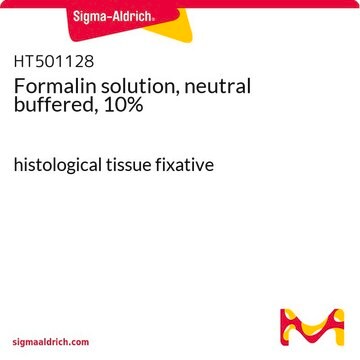Products may be shipped at a different temperature than the recommended long-term storage temperature. If the product quality is sensitive to short-term exposure to conditions other than the recommended long-term storage, it will be shipped on wet or dry-ice. If the product quality is NOT affected by short-term exposure to conditions other than the recommended long-term storage, it will be shipped at ambient temperature. As shipping routes are configured for minimum transit times, shipping at ambient temperature helps control shipping costs for our customers. For more information, please refer to the Storage and Transport Conditions document: https://www.sigmaaldrich.com/deepweb/assets/sigmaaldrich/marketing/global/documents/316/622/storage-transport-conditions-mk.pdf
P6148
Paraformaldehyde
reagent grade, crystalline
Sinónimos:
Polyoxymethylene
About This Item
Productos recomendados
grado
reagent grade
Nivel de calidad
densidad de vapor
1.03 (vs air)
presión de vapor
<1.45 mmHg ( 25 °C)
Formulario
crystalline
temp. de autoignición
572 °F
lim. expl.
73 %
mp
120-170 °C (lit.)
densidad
0.88 g/mL at 25 °C (lit.)
temp. de almacenamiento
2-8°C
cadena SMILES
[O-]#[C+H2]
InChI
1S/CH2O/c1-2/h1H2
Clave InChI
WSFSSNUMVMOOMR-UHFFFAOYSA-N
¿Está buscando productos similares? Visita Guía de comparación de productos
Categorías relacionadas
Descripción general
Aplicación
Producto relacionado
Palabra de señalización
Danger
Frases de peligro
Consejos de prudencia
Clasificaciones de peligro
Acute Tox. 4 Inhalation - Acute Tox. 4 Oral - Carc. 1B - Eye Dam. 1 - Flam. Sol. 2 - Muta. 2 - Skin Irrit. 2 - Skin Sens. 1 - STOT SE 3
Órganos de actuación
Respiratory system
Código de clase de almacenamiento
4.1B - Flammable solid hazardous materials
Clase de riesgo para el agua (WGK)
WGK 2
Punto de inflamabilidad (°F)
Not applicable
Punto de inflamabilidad (°C)
Not applicable
Equipo de protección personal
Eyeshields, Faceshields, Gloves, type P3 (EN 143) respirator cartridges
Elija entre una de las versiones más recientes:
¿Ya tiene este producto?
Encuentre la documentación para los productos que ha comprado recientemente en la Biblioteca de documentos.
Los clientes también vieron
Artículos
Available Fluorescent in situ hybridization (FISH) procedures, reagents and equipment.
Available Fluorescent in situ hybridization (FISH) procedures, reagents and equipment.
Available Fluorescent in situ hybridization (FISH) procedures, reagents and equipment.
Available Fluorescent in situ hybridization (FISH) procedures, reagents and equipment.
Protocolos
Cell staining can be divided into four steps: cell preparation, fixation, application of antibody, and evaluation.
Cell staining can be divided into four steps: cell preparation, fixation, application of antibody, and evaluation.
Cell staining can be divided into four steps: cell preparation, fixation, application of antibody, and evaluation.
Cell staining can be divided into four steps: cell preparation, fixation, application of antibody, and evaluation.
Contenido relacionado
Three-dimensional (3D) printing of biological tissue is rapidly becoming an integral part of tissue engineering.
Three-dimensional (3D) printing of biological tissue is rapidly becoming an integral part of tissue engineering.
-
How is shipping temperature determined? And how is it related to the product storage temperature?
1 answer-
Helpful?
-
-
How can I determine the shelf life / expiration / retest date of this product?
1 answer-
If this product has an expiration or retest date, it will be shown on the Certificate of Analysis (COA, CofA). If there is no retest or expiration date listed on the product's COA, we do not have suitable stability data to determine a shelf life. For these products, the only date on the COA will be the release date; a retest, expiration, or use-by-date will not be displayed.
For all products, we recommend handling per defined conditions as printed in our product literature and website product descriptions. We recommend that products should be routinely inspected by customers to ensure they perform as expected.
For products without retest or expiration dates, our standard warranty of 1 year from the date of shipment is applicable.
For more information, please refer to the Product Dating Information document: https://www.sigmaaldrich.com/deepweb/assets/sigmaaldrich/marketing/global/documents/449/386/product-dating-information-mk.pdfHelpful?
-
-
What is the shelf life of Product P6148, Paraformaldehyde?
1 answer-
The shelf life has not been assigned but guarantee of quality is 1 year from the time of receipt for unopened bottles stored at 2-8 °C. We expect the product to be of good quality for at least 2 years.
Helpful?
-
-
What is the Department of Transportation shipping information for this product?
1 answer-
Transportation information can be found in Section 14 of the product's (M)SDS.To access the shipping information for this material, use the link on the product detail page for the product.
Helpful?
-
-
How stable are Product P6148, Paraformaldehyde, solutions?
1 answer-
Buffered solutions of 2-4% can be stored protected from light for 2-3 weeks at 2-8°C.
Helpful?
-
-
What is the difference between formaldehyde and paraformaldehyde?
1 answer-
Paraformaldehyde is the polymeric form of formaldehyde. Paraformaldehyde is a solid, and formaldehyde is a gas. Formaldehyde solutions consist of formaldehyde gas dissolved in a solvent of some kind.
Helpful?
-
-
What is the difference between formaldehyde and paraformaldehyde?
1 answer-
Paraformaldehyde is the polymeric form of formaldehyde. It is a solid. Formaldehyde is a gas which when dissolved in water gives a formaldehyde solution. Commercially available formaldehyde solutions usually contain 10-15% methanol, which prevents the formaldehyde from forming the polymeric paraformaldehyde.
Helpful?
-
-
How to prepare solutions of Product P6148, Paraformaldehyde?
1 answer-
Paraformaldehyde does not dissolve but rather can be depolymerized in solution. Depolymerized solutions can be prepared in water with heating to 55-60°C. If necessary, further addition of 1-2 drops of a sodium hydroxide solution may be required. Some protocols suggest that paraformaldehyde should be prepared in buffered solutions such as phosphate buffer or PBS at approximately pH 7.
Helpful?
-
Active Filters
Nuestro equipo de científicos tiene experiencia en todas las áreas de investigación: Ciencias de la vida, Ciencia de los materiales, Síntesis química, Cromatografía, Analítica y muchas otras.
Póngase en contacto con el Servicio técnico












